2006 VOLKSWAGEN GOLF MK5 check engine
[x] Cancel search: check enginePage 38 of 444
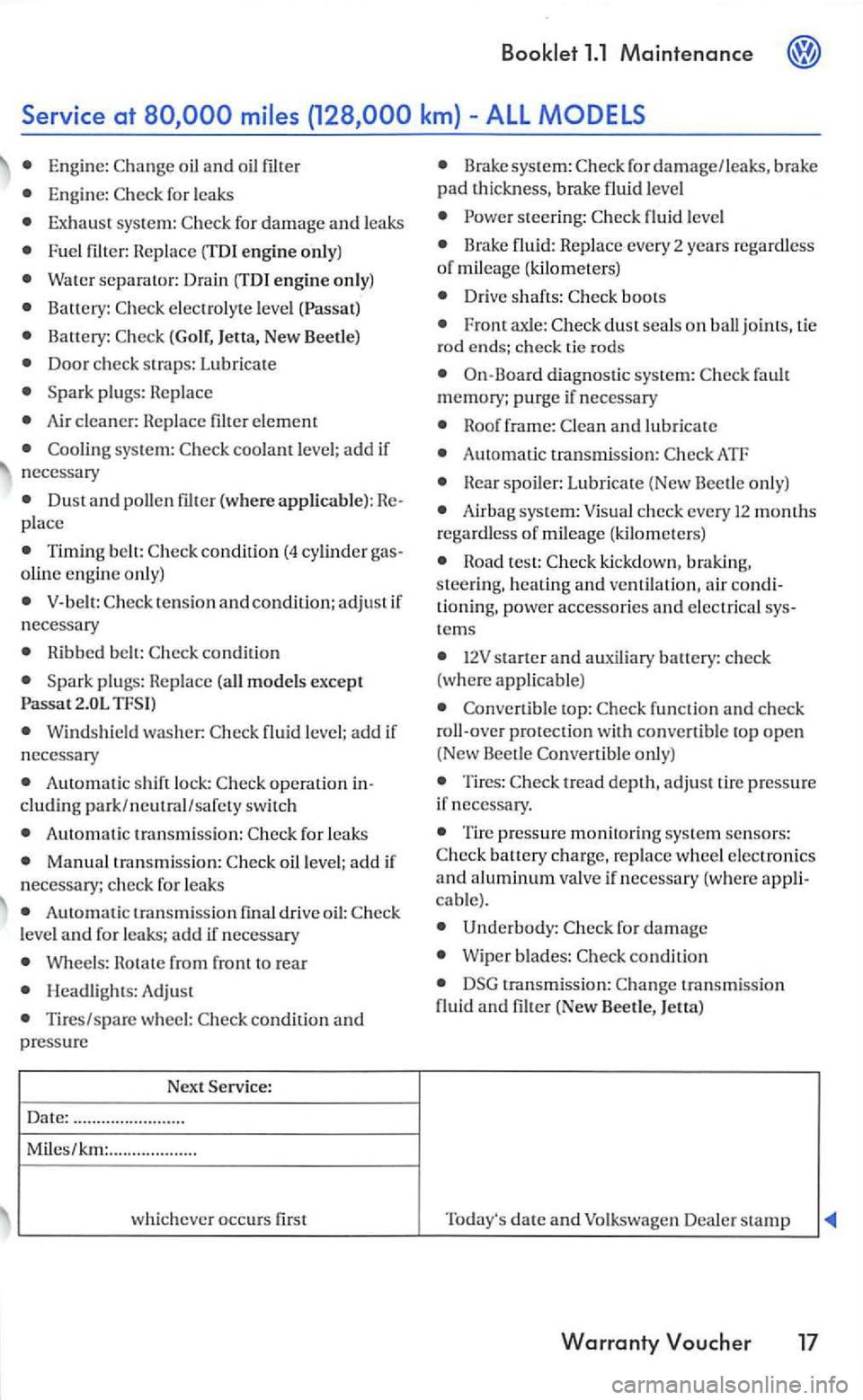
Booklet 1.1 Maintenance
oil and oil
for l eaks
for damage and leaks
engine only)
Water separator: Drain (TDI engine only)
Battery: electrolyt e leve l
Door check straps: Lubrica te
S pa rk p lugs: Replace
Air cleaner: Replace filter element
syste m : coolant leve l; add if
necessary
Dust and pollen (where applicable) : Replace
Tim ing belt:
V-be lt: tension and condition; adju st if necessary
Ribbed belt:
Spark plugs: Replace models except
Passat TF SI)
Wind shield washer: fluid level; add if
necessary
Auto matic shift lock:
Automatic transmiss ion: for leak s
oil leve l; add if
n ecessary; check for leak s
Automatic transm ission fmal drive oiJ: leve l and for leaks; add if necessa ry
Wheel s: Hotate from front to rea r
Hea dligh ts: Adjust
Tires/spare wheel: condition and pressure
Next S ervice:
Date: ....................... .
Miles/km: .................. .
whic hever occurs
first
Brake system: for damage/leaks, brake pad thickness, brake fluid leve l
steering: fluid leve l
boots
dust sea ls on ball joints, tie
rod ends; ch eck tie rod s
On-Board diagnostic sys tem: fault
m emory; purge if necessary
and lubricate
Automat ic transmission:
Air bag syste m: Visual check every 12 months
r egard Jess of mileage (kilometers)
Convertible top: function and check
roll-ove r protection convertib le to p open (New Beet le
tread deptJ1, adjust tire pressure
if necessa ry.
Tire press ure monitoring system sensors: battery ch a rge, replace wheel electronics
and aluminum valve if necessary (where applicable).
Underbody: f o r damage
W iper blades: con ditio n
transmission: tra nsmission fluid and filter (New Beetle, }etta)
T oday's
date and Volkswagen DeaJer stamp
Warranty
Page 40 of 444
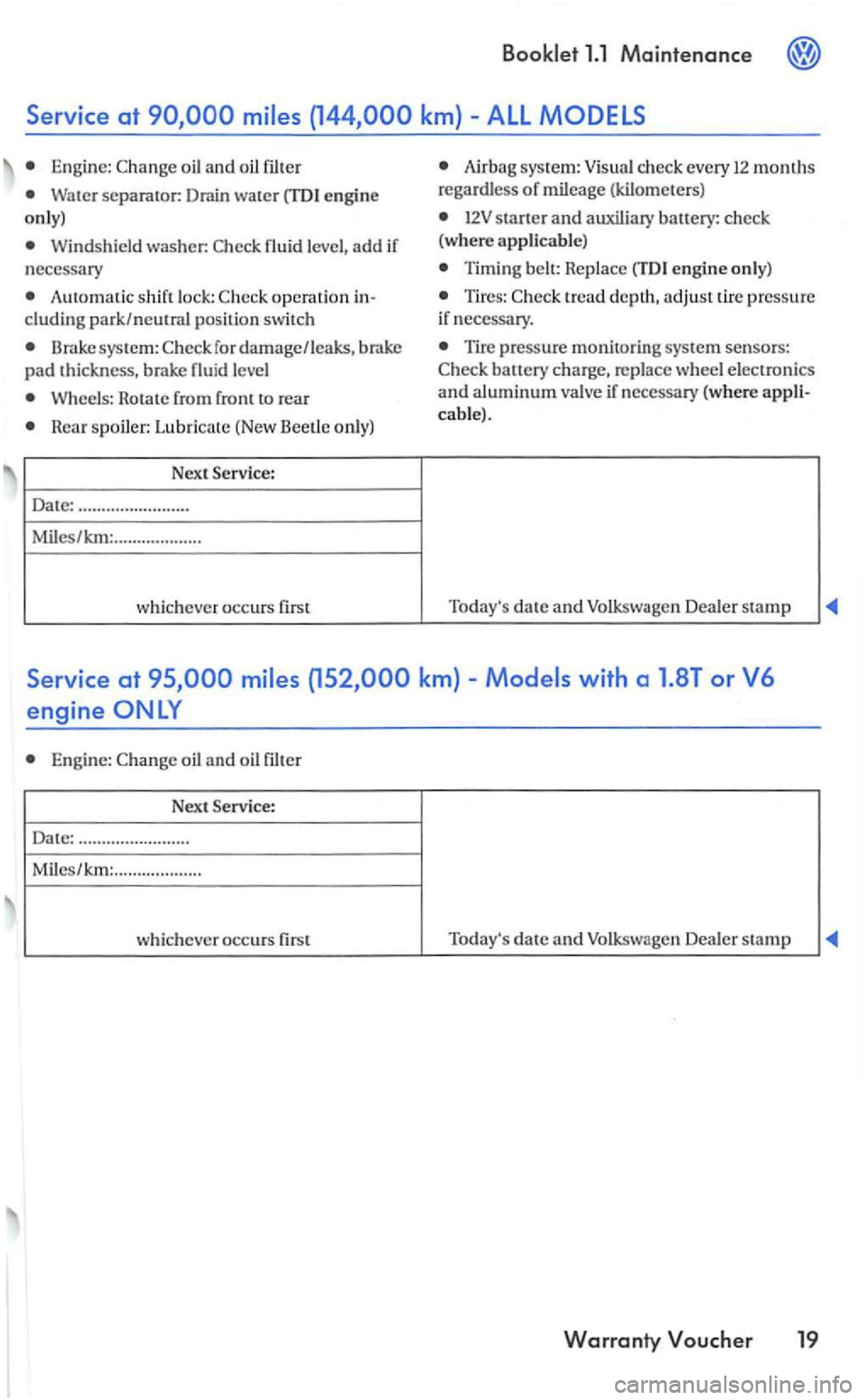
Eng in e:
Water separator: Drain water engin e
o nly)
Wind shiel d washer: fluid level, add if
necessary
Automatic shift lock: cluding park/neutral position switch
Brake system:
Wheels: Rotate from front to rear
Rear sp oiler: Lubric at e (New Beetle only)
Date: ........................
Mile
s/km: ...................
whic hever occurs
Airbag system: Visual ch eck every 12 months regardless of mileage (kilometers )
l2V sta rter and auxil iary battery: check
(where applicable)
Timi ng belt: Replace (TDI engine only)
Tires: tread depth, adjus t tir e pressure
if necessary.
Tire pressure monitoring sys tem sensors:
cable).
date and Volkswag en Dealer stamp
Service at
Engine: oil and oil
Date: ............ ........... .
M
iles/km : ....... ........... .
whichever occurs
Today's date and Volksw agen Dea ler stamp
Warranty Voucher 19
Page 41 of 444
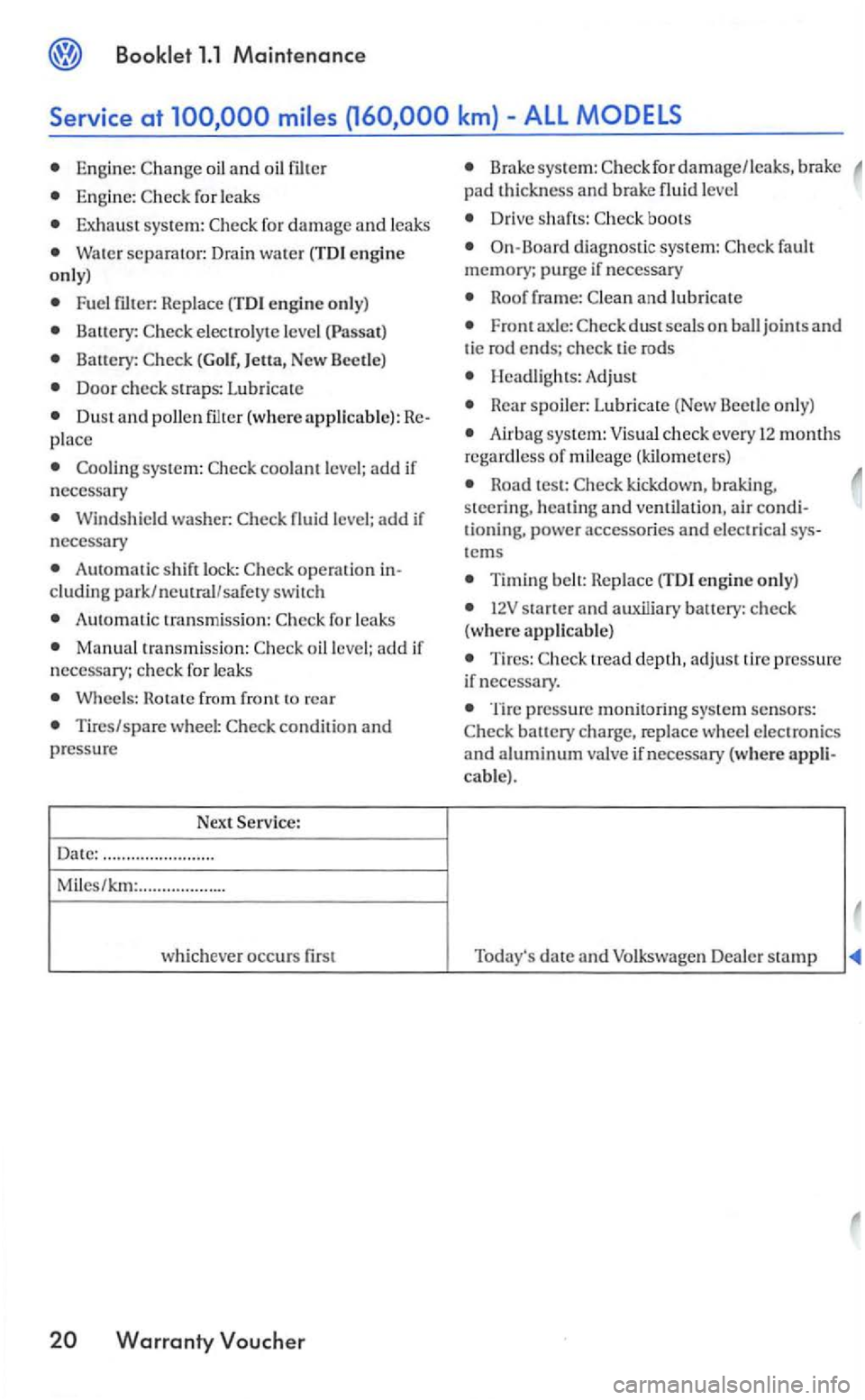
Engine: oil and oil filter
Engine: for leaks
Exhaust system: fo r damage and leaks
Water separator: Drain water (TDI e ngi ne only)
Fuel
electrolyte level
Battery: (Golf, )etta, New
Door check straps: Lubricate
s ystem:
Windshield washer:
Automatic sh ift lock:
Automatic transmiss ion:
Manual transmiss ion:
Wheels:
Tires/spare wheel :
Date: .................. ... ...
Miles/km: .................. .
which ev
er occurs first
Brake system: for damage/leaks, brak e pad thickness and brake fluid
Drive shafts: boots
On-Board diagnos tic system: fault
memory; purge if nece ssary
Roof frame: and lubricate
Front axle: jo int s and tie rod ends; ch eck tie rods
Hea dligh ts : Adjust
Rear sp oile r: Lub ricate (New Beetle only)
Airbag system: Visual check every 12 months regardless of mileage (kilom eters)
Road test: kickdown , braking, steering, heating and ventilation , air conditioning, powe r accessories and electrical systems
Timing belt: Replace (TDI engine only)
starter and auxiliary banery: check
( w here applicable)
T ires: tread dept h, adjust tire pressure
if nec essary _
Tire pressure monitoring system sen sors: battery charge, replace wheel electronics and aluminum valve if necessary (whe re appli
cable) .
date and Volkswagen Dealer stamp
Page 265 of 444
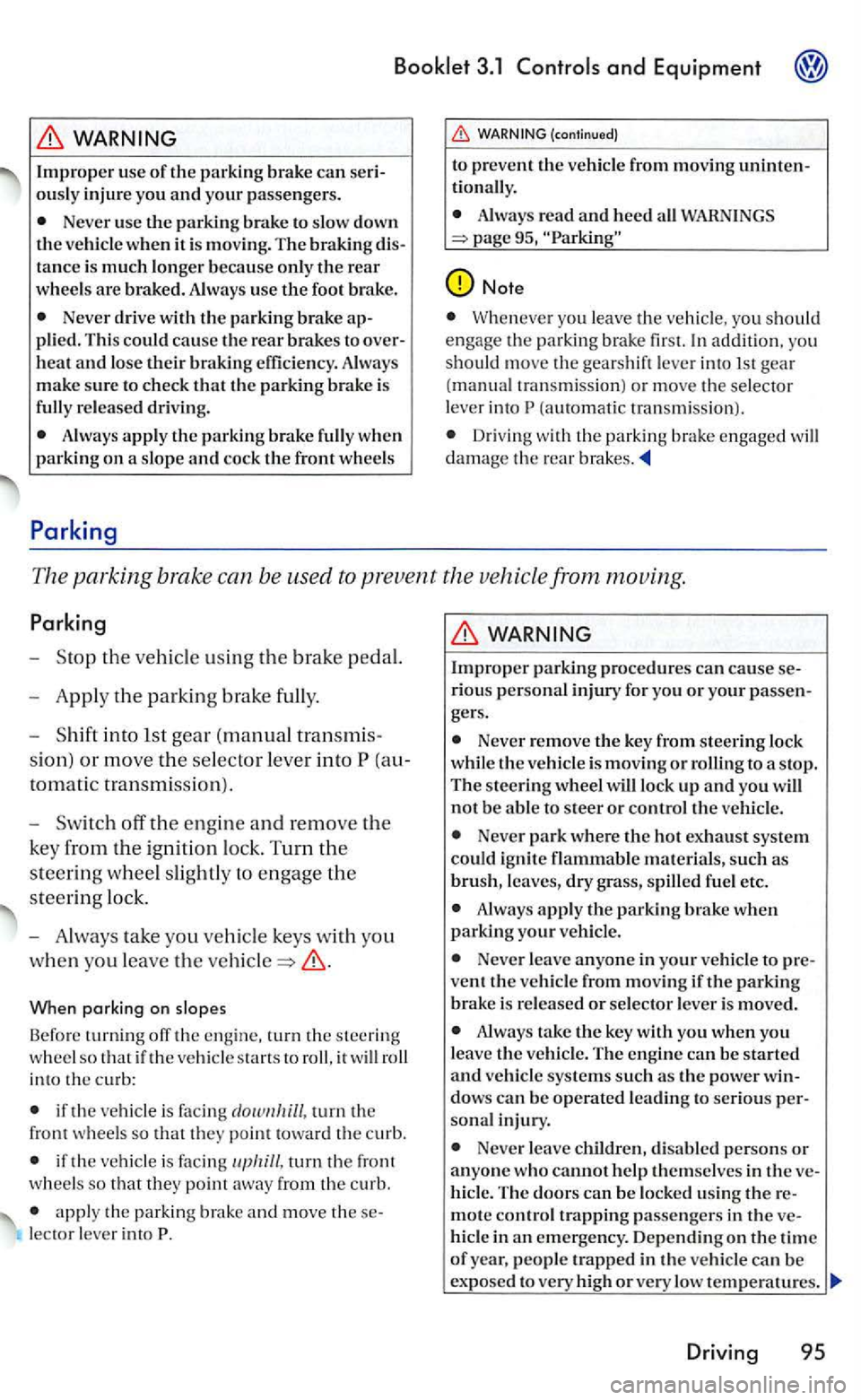
Booklet 3.1 Controls and Equipment
WARNING
Improper use of the parking brake can seri
ousl y injur e yo u and your passenge rs.
Neve r use the parking brake to slo w down
th e ve hicle when it is mov ing. The braking tanc e is much longer because only the rear wheel s are braked. Alwa ys use the foot brake.
Neve r drive with the parking brake plied. This could cause the rear brakes to overheat and los e their braking efficiency. Always
make sure to check that the parkin g is
fully re le a sed dri vin g.
Always apply the parking brake fully when
parking on a slope and cock the front wheels
Parking
(co ntinue d)
to prevent the vehicle from moving
Always read and h ee d WARNINGS
Whe never you leave th e veh icle, you should engage the parkin g
(aut om ati c tra nsm ission) .
Driving w ith the parking brake engaged will damage the rear
The parking bra ke can be used to prevent th.e vehicle from moving.
Parking
-the vehicle using the brake
-Apply th e parkin g brake full y.
-
into lst gear (m anual transmi s
sio n)
or move the se lector lever into
When parking on slo pes
Before turn ing off the engine, turn the steering
w hee l so that if th e vehicle starts roll, it will roll into the curb:
if the vehicle is facing turn the
f ront wheels so that they point toward the curb.
if th e veh ic le is facin g
apply the parkin g brake and m ove theselector leve r into
WARNING
Improper parki ng procedures can cause riou s personal injury for yo u or your passe n
gers.
Neve r remove the key from steering lock
while the ve hicl e is moving or rolling to a s top . The steering wheel will lock up and yo u will not be abl e to steer or contro l th e vehicle.
Neve r park where the hot exhaust system could ig nit e flammable materi als, such as brush, leaves, dry g ra ss, spill ed fue l e tc.
A lwa ys apply the parking brake when parking your vehi cle.
Neve r leave anyone in your vehi cle to vent the ve hicle from movin g if the parking brake is released or selector lever is moved.
Always take th e key with yo u when you leave the vehicle. The engin e ca n b e started and veh icle syste m s s uch as the powe r dows can be operated leadi ng to serious sonal injury.
Neve r leave childre n, disabl ed person s or anyone w ho cannot h elp th e mselves in the hicle. The doors can be locked using th e re-
m ote control trapping passe ngers in the h icle in an emerge ncy . Depending on the tim e of year, peo ple trapped in th e vehicle can be ex po sed to very high or very low temperatures.
Driving 95
Page 277 of 444

. . .. . . . . . . . . . . . .. . . 2
Brak es . .. . . .. .. .. . .. .. .. . .. .. .. . .. .. ... . 2 steering . . . . . . . . . . . . . . . . . . . . . . . . . . 8
Eng ine
management and exhaust sys tem . 9
Driving and protecting the
environment .. . .. .. .. .. .. .. .. . . . .. .. . 12
Break-in Period .. . .. .. .. .. .. .. .. .. .. .. .. . 12
towing .. .. . .. .. .. .. . .. . . .. . . .. .. . 15
Driv e economically and
core and
exterio r . . . . . . . . . . . . . . . .. . 22
Core of the in terior . . . . . . . . . . . . . . 28
Acce ssories, new parts, repairs
and modifications .. .. .. .. .. .. .. .. .. 31
Accessories and ports . . . . . . . . . . . . . . . . . . . 31
Repair s ond technical modifications . . . . . . 32
phones and
modules . . . . .. .. . . . . . . . . . . . . . . .. . 34
Checkin g and .. .. .. .. .. .. .. . 35
supply .. .. .. .. .. .. .. . .. .. .. .. .. . .. .. 37 Working in the engine comportment . . . . . 39
Engine .. .. .. .. .. .. .. .. .. .. . .. . .. .. .. . 42
................................. 47
Washer and windsh ield wiper blades
Broke . . . . . . . . . . . . . . . . . . . . . . . . . . . . . . 53
and spore . . . . . . . . . . . .. . .. . . .. .. .. .. . .. . .. .. 82
Emergency or opening . . . . . . . . . . . 88
Fuses . . . . . . . . . . . . . . . . . . . . . . . . . . . . . . . . . . .
. . .. . .. .. .. .. .. .. .. 93
Jump starting .. . .. .. . .. .. . .. . .. .. .. . .. .. . 99 Towing .................................. ........................
index .................
Page 283 of 444
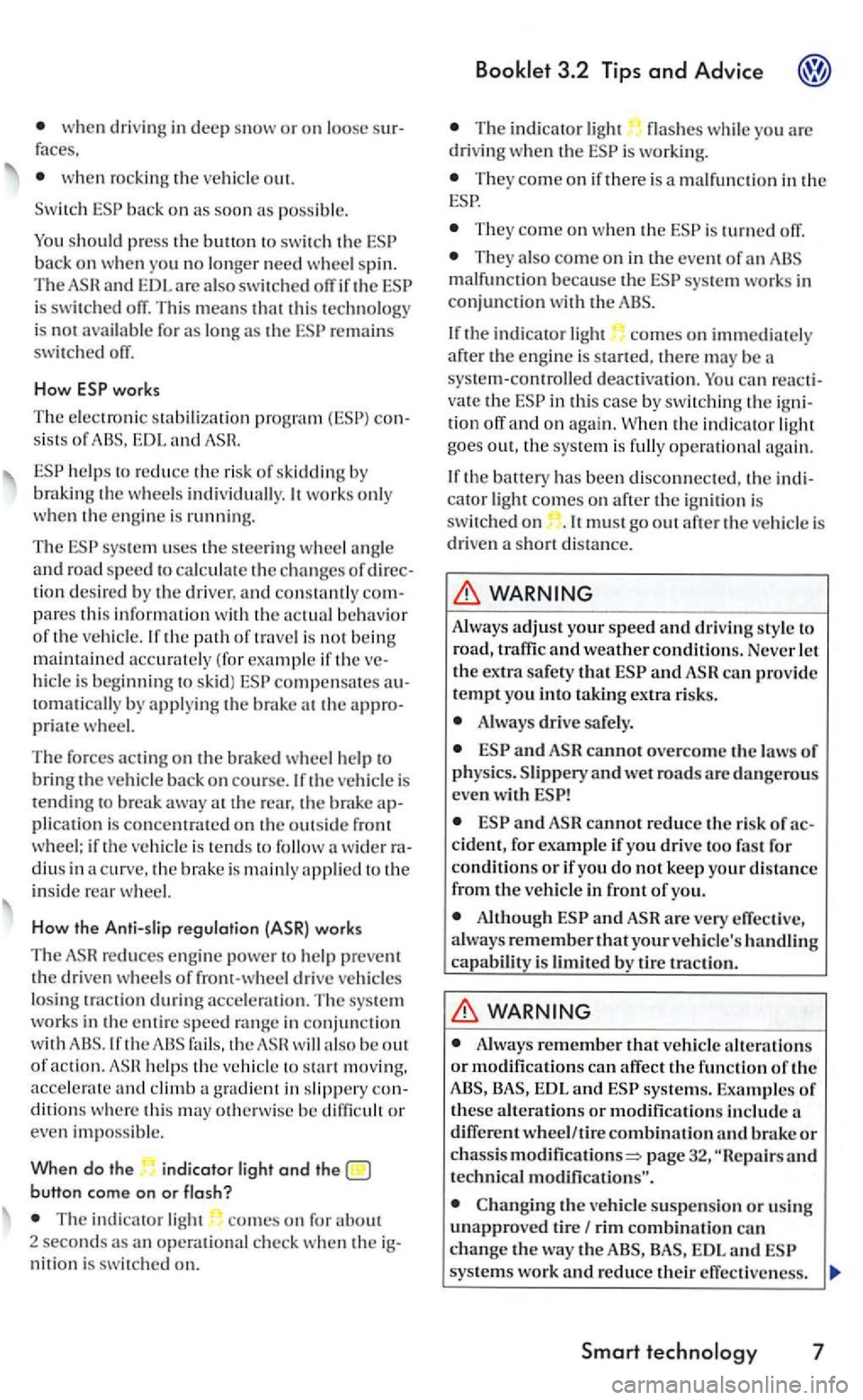
when dri ving in deep snow or on loose faces.
w he n r ocking the ve hicl e out.
Switch
ba ck on w he n yo u no longer need wheel s pin. The
remains switch ed oiT.
Ho w
works
The electroni c stab ilization progra m
helps to reduce the ris k of skiddin g braking th e w heels individually. works o nl y
w he n th e e ngine is ru nning.
The sys te m uses th e steering whee l an gle and road speed to calculate th e changes of tio n desired by the driver, and constantl y pares thi s informat ion with the actual behavior of the vehicl e. accurately ( for example if the hicle is beginni ng to skid ) tomatically by applyin g th e at the priate wheel.
The forces acti ng on the braked wheel help to
b rin g the vehicle back on course. th e ve hicl e is tending away at the rear, the brake
wide r dius in a curve. th e brake is mainly applied to the
in sid e wheel.
How the Anti-slip regulation
reduces engine powe r to he lp preven t the driven wheels of front-wheel d rive vehicles
losing traction during acceleration. The sys te m works in the entire speed ra nge in conjunctio n
with fails , the will a lso be out of action. h elp s the ve hicl e to moving. accele rat e and climb a grad ient in slipp ery d itions wh ere thi s may o therwise be diffi cult or even imposs ibl e.
When do the indicator light and the button come on or flash?
T he indicator light comes on for about
2 seconds as o perati o nal check when the
3.2 Tips and Advice
The indicator ligh t flashes while yo u are driv ing when the is wo rking.
They come on if there is a malfun ction in the
They come on when the
Th ey also come o n in the event of an malfunction because the system works in conjunction with the ABS.
the indicator light comes on immedia tel y
a fter the engine is started , th ere m ay be a
sys tem-controlled deactivation. You can vate the tion off and on agai n. th e in dicator ligh t
goes out , the sys te m is full y ope rational again.
the battery has been disconnected, th e
A lways adjust your speed and driving style to road, traffi c and weather conditions. Never le t the extra safety that can provide tempt you into taking extra risk s.
Alway s drive sa fe ly .
and
cannot reduc e the ris k of cident, for example if you drive too for conditions or if you do not keep your distance from the vehicle in front of yo u.
Although
Always remember that vehicle alterations or modificatio ns can affec t the functio n of the EDL and
different wheel/ tire combination and brake or chassis modifications=> page 32, and technical modifi cations".
Changing
EDL and sys te m s work and reduce their effecti veness.
Smart
Page 289 of 444
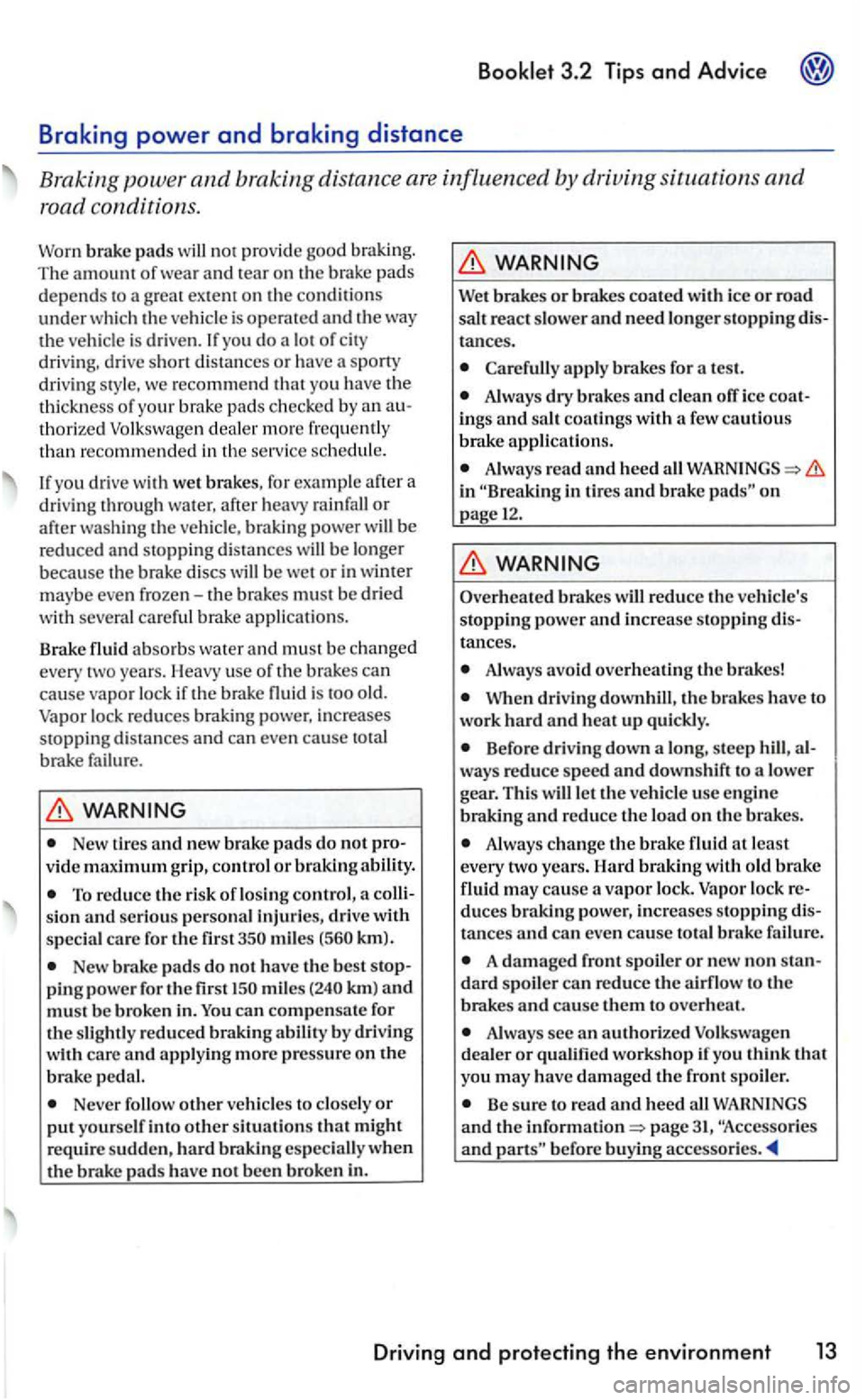
Booklet 3 .2 Tips and Advic e
recommend that you have the
thi ckne ss of your brake pads checked by an au
t horized Vol kswagen dealer mo re fre quent ly
t h an recommende d in the serv ice sched ule.
you drive with wet brakes, for example afte r a
dri ving through water, after heavy rainfall or after washing the ve hicle, braking power be
reduced and s to ppin g distances will be longer
because the brake discs will be we t or in winter mayb e eve n frozen-the brakes must be dried
with several ca re ful brak e applicatio ns.
Brak e fluid absor bs water
and must be changed
every two years. Heavy use of the brakes can cause vapor lock if the brake fluid is too old.
Vapor lock redu ces braking power, increases
stopping distances and ca n even cause total
brake failure.
New tires and new bra ke pads do no t pro
v id e m aximum gri p, control o r b raking abil ity.
To red uce the risk of l osi ng control, a s io n an d se rio us perso nal injuries, drive with
specia l ca re for the first 350 miles (560 km).
New brake pads do not have th e best sto p
ping power for the fir st ISO mile s (240 km ) and
m ust be b roken in. can compensate for the slightly reduced braki ng abil ity by dri ving care and applyin g more pressure on th e
brake pedal.
Never follow oth e r veh icles to close ly or
p u t you rse lf in to other s ituations th at might
requ ire su d den , hard bra king especially when the brake pads have not been broken in.
apply brakes for a test.
Always dry brakes and clea n off icc coat
i ngs an d salt coatings with a few cautious brake applications.
A lways read and heed in in tire s and brake on page 12.
Always avoid overheati ng the brakes!
When driving downhill, t11 e brakes have to
work har d and h eat up quickly.
Before driving down a lo ng, steep hill, al
ways reduce speed and downshift to a lower
gear. This will let the vehicle usc engine
Always ch ange th e brake fluid at l east
every two years. Hard braki ng wi th o ld flui d may cause a va po r lock . Vapor loc k duces powe r, inc reases stoppin g di stan ces and can even cause tota l b rak e failure.
A damaged front spoiler or n ew non standard spoiler can reduce t h e airflow to th e
brakes and cause them to ove rh eat.
Always see an authorized Volkswag en
dealer or qualified workshop
Be sure to re ad and heed all and th e page
Driving and protecting the environm ent 13
Page 291 of 444
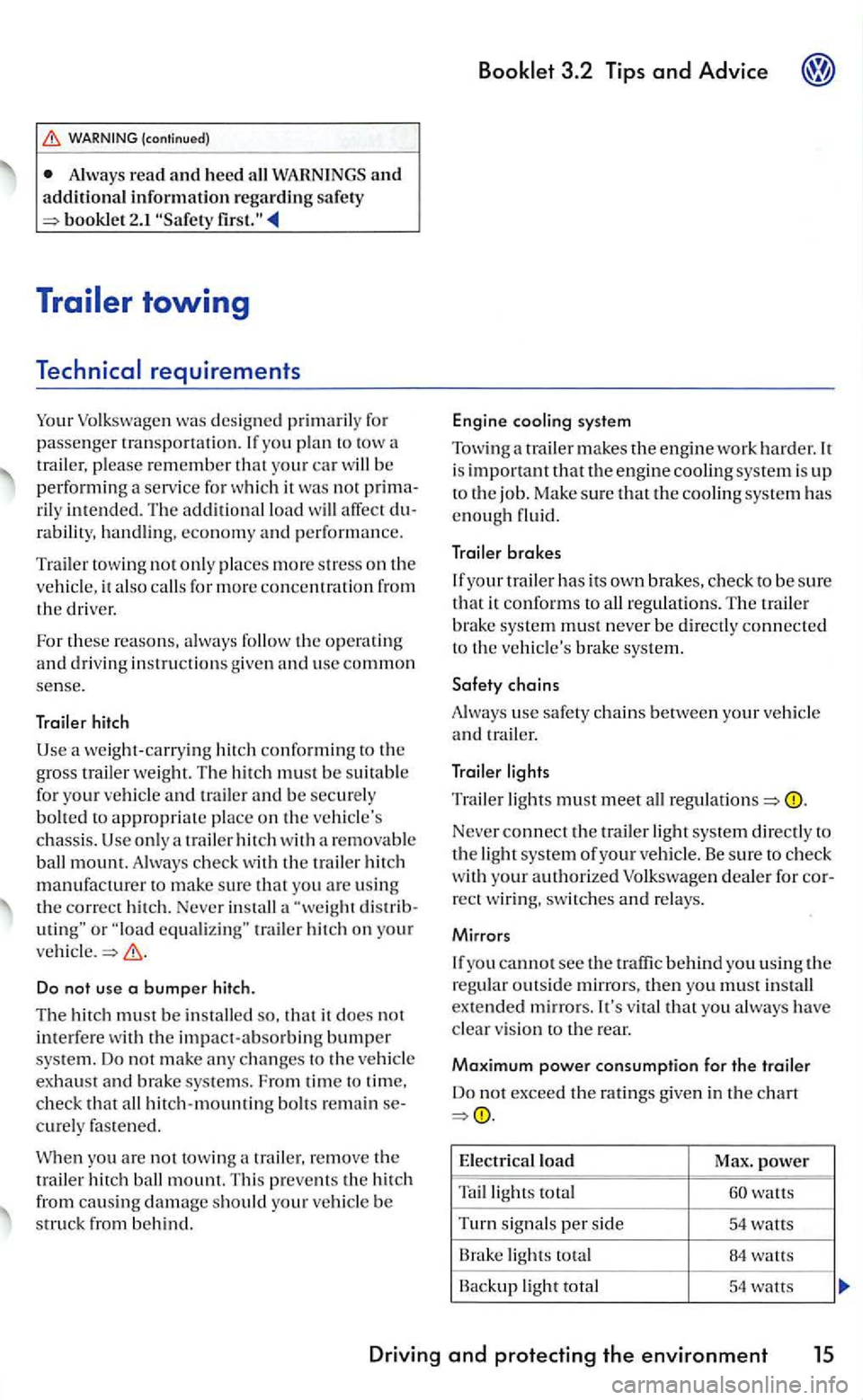
WARNING (c o ntinu ed )
Alwa ys read and heed all W ARN IN GS an d additional information regarding sa fet y booklet 2 . I
yo u plan to tow a
tr ailer, p lease re m ember th a t yo ur car will be performing a serv ice for which it was not
ra b ility, ha ndl ing, econ o m y and performa nce.
Tra
ile r towin g not o nl y places more stress on the ve hicl e, it als o calls fo r more concentratio n fr o m the driver.
For these re a so ns, always follow th e o pe ra ting
and d rivi ng instructio ns given and use common sense.
Trail er hit ch
trail er hit ch on your ve hicle.
D o not use a bumper hitch.
The hitch must be installed so, it does not
interfe re the impact-absorbin g bumper system. Do not make any ch an ges to th e ve hicl e
ex haust and b rake system s. Fro m time to tim e, check that all hi tch-mounting bo lt s remain curely fas te ned .
When you are no t towin g
Engine cooling system
Tow ing a tra iler makes the engine wo rk ha rder. is important that th e engine cooling system is u p
t o the job. Ma ke s ure that th e coo ling system has enough fluid .
Traile r bra kes
Never connect the tr a iler light syste m direc tly to the light syste m of your ve hicle . Be su re to check wit h your authorized Volkswage n dealer for rec t w iring, switches
you alwa ys have clear v is ion to th e rear.
Maxim um power consumption for the traile r
Do not exceed the ratings given in the c hart
E lectric al load
Max . power
T ailligh ts total watts
T urn sig na ls p
er sid e 54 watts
B rak e lig hts total 84
Backup light total 54 walls
Driving and protecting the environ ment 15